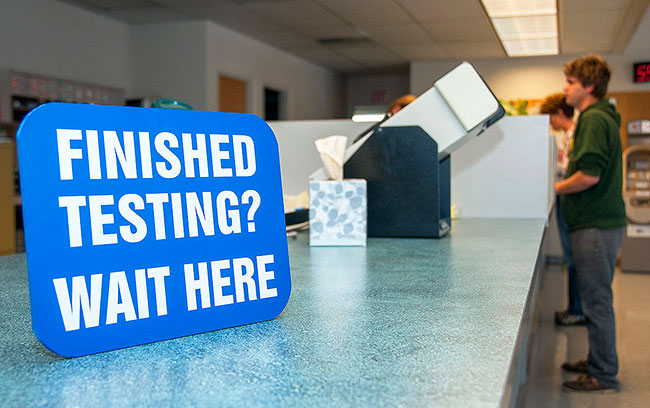
The automotive industry is a heavily regulated industry and most of the regulating (virtually all of it) is aimed at public health and safety. We require emission standards, mileage standards, safety standards, air bags, crash testing, and so on.
We require anyone who wishes to drive a car to receive training in the operation of a car (and further training for motorcycles or trucks) and then to take both a written and a practical test. Young people go through a long apprenticeship during which they cannot drive alone. State governments issue an operating license which is required of anyone wishing to use a car, not just to buy one. They pay for the privilege. And these state issued licenses are entered into a national data bank.
We require anyone who wishes to own a car to have the car inspected on a yearly basis and to provide evidence of a passed inspection before the car’s license may be renewed. The owner pays for both the inspection and the license renewal, every year. In most states, they also pay a property tax on the car itself. We also require anyone who wishes to own a car to purchase an insurance policy… not just to protect themselves, but to protect every other driver on the road, especially those whom they injure or kill with their car. Once again, they pay for this privilege.
And this regulation can be very burdensome.
Even a cursory visit to any municipal traffic court will demonstrate just how heavily policed this business of licensing and inspecting and insuring actually is. The state takes the process with great seriousness, and imposes significant fines for any breach of this social contract; the state may even confiscate the cars and/or imprison repeat violators. And we the people submit to this with very little outcry.
It is here that defenders of “gun rights” make this important distinction (though actually they are the owners’ rights that are in question; a gun possesses no constitutional rights any more than a gun industry does). Cars are nowhere mentioned in the US Constitution or the Bill of Rights; guns are. Thus, owning cars is a privilege, a privilege we pay for. Owning guns is a constitutional right, not a privilege.
This is true, and it is an important point to grant to the opponents of gun regulation. But let us examine that claim more closely, too. The Second Amendment to the US Constitution states the following:
A well regulated militia being necessary to the security of a free state, the right of the people to keep and bear arms shall not be infringed.
The first two terms of importance in this amendment refer to a “militia,” and yes, to “regulation.” Viewing this amendment as an anthropologist might, we see that the citizen who is imagined in this sentence is the member of a state militia who, for that very reason, keeps a front-loading musket or pistol in his or her home. This militia was intended to defend the “security of a free state,” not Montana ranchers. And the reason for this is that the Constitutional Framers were suspicious of a centralized government with a standing army. Our militia was to be the army, reserves to be called up as needed.
The point was that we were not to conduct our affairs as the British Empire conducted its affairs, with an enormous and far-flung body of army, navy and marines. Our free state did not pit individual citizens against a tyrannical state; rather, we the people constituted that free state, a state to which they pledged their lives and sacred honor in defense.

The tragedy at the heart of the NRA’s pretend concern for individual gun owners is that it pits the individual citizen against an armed state. It is entirely and shamefully unpatriotic in its views of the relation of a citizen to a government of and by the people.
The NRA also appears to believe, amazingly, that an independent citizens’ militia could stand up against the armed military might of the United States of America. The reason no such citizen militia could is that the government does not permit them to own weapons that are in any way parallel to the weapons of state. We regulate those weapons. You may not purchase a bazooka. Or a tank. Or a nuclear weapon.
What “the right of a people to keep and bear arms” means in 2018 is the question, in a country with an overwhelming standing army and a massive police apparatus that is now once again permitted to purchase military-grade weapons. I say it again: buying (and hence keeping) is one side of this equation; bearing (and hence using) them is another. Both must be “well regulated.”
Conservative lawyers and judges disagree, and they tout a landmark 2008 US Supreme Court decision to defend their view. Here again, it is imperative for those who support gun regulation to admit that this is so and to take up their well-intentioned arguments with care and due respect.
The decision was written by the late Justice Antonin Scalia (1936-2016), whose judicial philosophy came to be known as “originalism” or “strict constructionism.” There was something almost biblical about Scalia’s attachment to the US Constitution, his belief in its “clear meaning” and that “common sense” was sufficient to reveal that meaning.
Far stranger for a Roman Catholic like himself, Scalia seemed to resist any attempt to read the sacred text through the tradition.
The problems with Scalia’s conception of the Constitution’s “original intent” and its “clear meaning” were obvious. It was not simply the apparent constitutional fundamentalism that caused wonder and dismay; it was his apparent refusal of history, and the stubborn refusal to admit moral progress in a society that has evolved and continues to do so.
Many of the cultural attitudes enshrined in the Bill of Rights that were ratified in 1791 are decidedly not our attitudes today: women could not vote; children had no rights to speak of; and most persons of African descent were enslaved, counting as three-fifths of one person for the purposes of assigning congressional representatives to the mainly southern states.
Justice Scalia was well aware of these problems, and for this very reason, he referred to his conception of originalism as “the lesser evil,” not as a positive interpretive good. In an important and overlooked essay which he published just three years after coming to the US Supreme Court, he said as much [“Originalism: The Lesser Evil” University of Cincinnati Law Review 57.3 (1989): 849-865]. He was trying not to be a methodological fundamentalist.
Justice Scalia freely admitted the fact of shifting cultural attitudes, and he admitted that many of them were signs of social and cultural progress. While public flogging was an acceptable punishment in 1791, he acknowledged, he would not be willing to support such punitive measures today. But that, he added coyly, is not an issue which is ever likely to come before the US Supreme Court. It has already been adjudicated in the broader society.
Many of us are not so sanguine about the stability of such matters of moral taste, which is precisely what makes any kind of fundamentalism, biblical or constitutional, worrisome. Moral values, like most social norms, are fragile things. Things do change, but not always for the better. We may eliminate flogging in public, then initiate water-boarding in private.
Nonetheless, the virtues of Justice Scalia’s method were apparent in the important gun decision he wrote in 2008, District of Columbia v Heller [554 U.S. 570]. The case involved a Washington, DC statute that required any firearms kept in a private home to be non-functioning. As was his custom, Justice Scalia went first to the US Constitution, and specifically to the Second Amendment.
Curiously, Justice Scalia passed over the first phrase, the phrase with the all-important mention of militias and regulation, suggesting that it was merely the preface to the main point. (So much for strict constructionism). Rather, Scalia went to the books (even to Webster’s Dictionary), in order to parse every shade and nuance of meaning as to what “keeping and bearing arms” may have meant in 1791.
The lion’s share of the constitutional philology in which Scalia engaged concentrated on the term ‘arms’, and that will be the primary means with which we may move forward with common sense gun control ten years later.
Justice Scalia freely admitted that the US government possesses modern weapons which do not qualify as “arms” in the 1791 sense, and that these weapons may clearly be regulated; he thus pointed out one path forward through which gun control might be justified. AR-15s are not “arms” in the 1791 sense, either.
Justice Scalia also made a casual observation which did not receive sufficient attention in this debate. While he defended the place of guns in the home, he took it as given that the US Constitutional Framers simply took for granted that guns did not belong in public places, like schools and houses of worship. He mentioned both explicitly. This is worth thinking about more closely: an arch-conservative judicial theorist like Antonin Scalia, as recently as one decade ago, considered it self-evident that the original intent of the Second Amendment did not promote a right to bear arms in schools.
When the President of the United States, in tandem with NRA President Wayne LaPierre, suggests that the reasonable response to the latest Parkland school shooting is to place more guns in schools, this is more than an example of being tone deaf. It is a failure to be serious about anything other than defending the gun industry. Whose interests are served by the proposal that the best way to deal with the problem of guns in schools is more guns in schools? Our youth have been very clear on this point: the gun industry profits. Not them. Not us.
